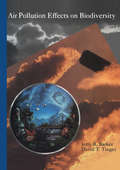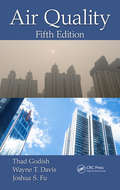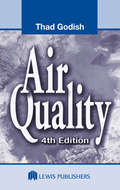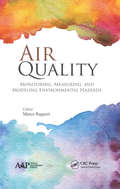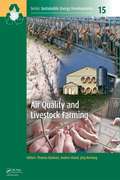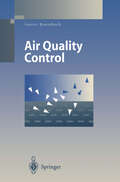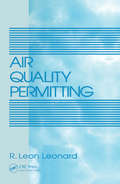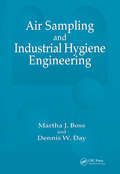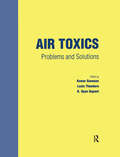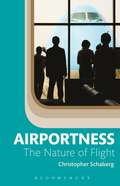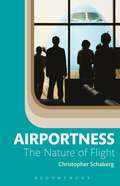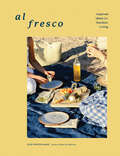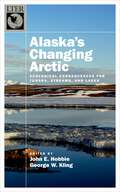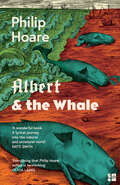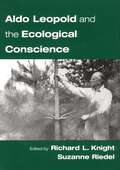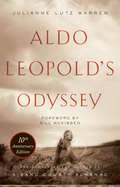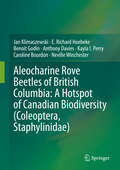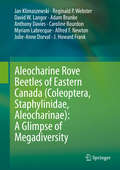- Table View
- List View
Air Pollution Effects on Biodiversity
by David T. Tingey Jerry R. BarkerBiodiversity is the delicate ecological balance within biological systems such as species and populations. Evidence suggests air pollution disrupts and impoverishes ecosysytems processes, and genetic and population diversity. Based on a symposium conducted by the EPA's Environmental Research Laboratory, this book pulls together current knowledge on the subject, assesses its relevance, and offers a framework for future research on the impact of air pollution on biodiversity through all levels of biological organization. This text is particularly timely due to acid rain and other toxic problems. The text also discusses the best available control technology, management practices, alternative chemicals, and legislative ways to reduce the impact of air pollution on biodiversity.
Air Quality
by Thad Godish Wayne T. Davis Joshua S. FuThe fifth edition of a bestseller, Air Quality provides students with a comprehensive overview of air quality, the science that continues to provide a better understanding of atmospheric chemistry and its effects on public health and the environment, and the regulatory and technological management practices employed in achieving air quality goals.
Air Quality
by Thad Godish Joshua S. FuOzone-destroying chemicals, greenhouse gases, and dangerous airborne substances that were once thought to be benign are the most urgent issues facing air pollution control experts. Students need a thorough, updated reference that explores these current trends while also covering the fundamental concepts of this emerging discipline. A new re
Air Quality: Monitoring, Measuring, and Modeling Environmental Hazards
by Marco RagazziThis title includes a number of Open Access chapters. This new compendium provides a nuanced look at monitoring, measuring, and modeling air quality pollution in conjunction with its effects on public health and the environment. Air pollution has been proven to be a major environmental risk to health. Protecting and improving air quality requires knowledge about the types and levels of pollutants being emitted. It also requires the best possible measurement and monitoring capabilities. The chapters in this volume serve as a foundation for monitoring, measuring, and modeling air pollution.
Air Quality: Monitoring, Measuring, and Modeling Environmental Hazards
by Marco RagazziThis title includes a number of Open Access chapters. This new compendium provides a nuanced look at monitoring, measuring, and modeling air quality pollution in conjunction with its effects on public health and the environment. Air pollution has been proven to be a major environmental risk to health. Protecting and improving air quality requires knowledge about the types and levels of pollutants being emitted. It also requires the best possible measurement and monitoring capabilities. The chapters in this volume serve as a foundation for monitoring, measuring, and modeling air pollution.
Air Quality and Livestock Farming (Sustainable Energy Developments)
by Thomas Banhazi Andres Aland Jörg HartungAir quality has a direct influence on health, welfare and production performance of livestock as the high concentrations of noxious gases, dust and airborne microorganisms are likely to reduce production efficiency and the general welfare of farm animals. Long term exposure to particulates in livestock buildings might also affect the respiratory health of farm workers. Dust in animal buildings contains many biologically active substances such as bacteria, fungi, endotoxins and residues of antibiotics (as a result of veterinary treatments) that are suspected to be hazardous to human health. Furthermore, air pollutants emitted from livestock buildings can reduce air, water and soil quality and can potentially undermine the health of nearby residents. Airborne emissions include ammonia, methane, nitrous oxide, particulates like dust and microorganisms. In addition, other potentially harmful substances such as heavy metals, antibiotic residues and components of disinfectants might be also emitted from livestock building that are potentially damaging to ecosystems. In this book, key aspects of agricultural air quality, such as monitoring, managing and reducing airborne pollutants in and around livestock facilities are reviewed. Features: addressing the raising awareness of the importance of optimal health and welfare for lifestock species with contributions from international specialists and researchers providing up-to-date information for professionals involved in modern animal producti This book will be useful for farming professionals, academics, students, policy makers, business leaders, regulatory bodies and agricultural consultants.
Air Quality and Livestock Farming (Sustainable Energy Developments)
by Thomas Banhazi Andres Aland Jörg HartungAir quality has a direct influence on health, welfare and production performance of livestock as the high concentrations of noxious gases, dust and airborne microorganisms are likely to reduce production efficiency and the general welfare of farm animals. Long term exposure to particulates in livestock buildings might also affect the respiratory health of farm workers. Dust in animal buildings contains many biologically active substances such as bacteria, fungi, endotoxins and residues of antibiotics (as a result of veterinary treatments) that are suspected to be hazardous to human health. Furthermore, air pollutants emitted from livestock buildings can reduce air, water and soil quality and can potentially undermine the health of nearby residents. Airborne emissions include ammonia, methane, nitrous oxide, particulates like dust and microorganisms. In addition, other potentially harmful substances such as heavy metals, antibiotic residues and components of disinfectants might be also emitted from livestock building that are potentially damaging to ecosystems. In this book, key aspects of agricultural air quality, such as monitoring, managing and reducing airborne pollutants in and around livestock facilities are reviewed. Features: addressing the raising awareness of the importance of optimal health and welfare for lifestock species with contributions from international specialists and researchers providing up-to-date information for professionals involved in modern animal producti This book will be useful for farming professionals, academics, students, policy makers, business leaders, regulatory bodies and agricultural consultants.
Air Quality Control: Formation and Sources, Dispersion, Characteristics and Impact of Air Pollutants — Measuring Methods, Techniques for Reduction of Emissions and Regulations for Air Quality Control (Environmental Science and Engineering)
by G. BaumbachAir quality and air pollution control are tasks of international concern as, for one, air pollutants do not refrain from crossing borders and, for another, industrial plants and motor vehicles which emit air pollutants are in widespread use today. In a number of the world's expanding cities smog situations are a frequent occurrence due to the number and emission-intensity of air pollution sources. Polluted air causes annoy ances and can, when it occurs in high concentrations in these cities, constitute a seri ous health hazard. How important clean air is to life becomes apparent when consid ering the fact that humans can do without food for up to 40 days, without air, how ever, only a few minutes. The first step towards improving the air quality situation is the awareness that a sound environment is as much to be aspired for as the development of new tech nologies improving the standard of living. Technical progress should be judged es pecially by how environmentally benign, clean and noiseless its products are. Of these elements, clean air is of special concern to me. I hope that this book will awaken more interest in this matter and that it will lead to new impulses. Due to the increasing complexity of today's machinery and industrial processes science and technology can no longer do without highly specialized design engineers and opera tors. Environmental processes, however, are highly interdependent and interlinked.
Air Quality Permitting
by R. Leon LeonardThis practical book covers all of the fundamentals for obtaining air quality permits for new sources of air pollutant emissions and Title V operating permits for operating sources. Written for facility environmental managers, consultants, and air quality regulatory staff, Air Quality Permitting provides a thorough discussion on the strategies of successfully permitting a facility.
Air Quality Permitting
by R. Leon LeonardThis practical book covers all of the fundamentals for obtaining air quality permits for new sources of air pollutant emissions and Title V operating permits for operating sources. Written for facility environmental managers, consultants, and air quality regulatory staff, Air Quality Permitting provides a thorough discussion on the strategies of successfully permitting a facility.
Air Sampling and Industrial Hygiene Engineering
by Martha J. Boss Dennis W. DayWe know certain chemicals cause problems in the workplace. The issues now are: Where do they occur in the workplace? How can we best evaluate them? What are the procedures for dealing with them safely? Many books simply define the problem and tell you that you need a program. Air Sampling and Industrial Hygiene gives you a guide to air sampling protocols from start to finish. The book presents sampling technology updated with today's tools - such as microcircuitry and remote sensing. The authors emphasize an interdisciplinary approach to understanding how air monitoring can adequately report current environmental conditions associated with outdoor media, indoor remediation efforts, proximal equipment, interior line monitoring, and the interrelationship of ventilation parameters. In addition to providing the how-tos of sampling, this guide covers the basics of chemical risk assessment, biological assessment, engineering evaluation of mechanical system design criteria, and chemical or process engineering hazard assessments. It presents the information using text, text outlines, graphics, and pictures - including cross sections of instrumentation and side bars to elaborate on complex concepts.Faulty readings caused by poor sampling techniques can be very costly. This book provides the how-tos for making design engineering and on-site decisions as to instrumentation selection and scheduled usage. Air Sampling and Industrial Hygiene Engineering will allow you to complete the sampling process systematically and correctly from initial suspicions to the use of obtained results.
Air Sampling and Industrial Hygiene Engineering
by Martha J. Boss Dennis W. DayWe know certain chemicals cause problems in the workplace. The issues now are: Where do they occur in the workplace? How can we best evaluate them? What are the procedures for dealing with them safely? Many books simply define the problem and tell you that you need a program. Air Sampling and Industrial Hygiene gives you a guide to air sampling protocols from start to finish. The book presents sampling technology updated with today's tools - such as microcircuitry and remote sensing. The authors emphasize an interdisciplinary approach to understanding how air monitoring can adequately report current environmental conditions associated with outdoor media, indoor remediation efforts, proximal equipment, interior line monitoring, and the interrelationship of ventilation parameters. In addition to providing the how-tos of sampling, this guide covers the basics of chemical risk assessment, biological assessment, engineering evaluation of mechanical system design criteria, and chemical or process engineering hazard assessments. It presents the information using text, text outlines, graphics, and pictures - including cross sections of instrumentation and side bars to elaborate on complex concepts.Faulty readings caused by poor sampling techniques can be very costly. This book provides the how-tos for making design engineering and on-site decisions as to instrumentation selection and scheduled usage. Air Sampling and Industrial Hygiene Engineering will allow you to complete the sampling process systematically and correctly from initial suspicions to the use of obtained results.
Air Toxics: Problems and Solutions
by Kumar GanesanThis timely new workbook is the result of a year-long effort by a group of university professors who first met at Montana Tech during the summer of 1994 for a college faculty workshop. The workshop was funded by the National Science Foundation's support for those faculty developing courses in the newly emerging field of air toxics. Part I of the book contains over 100 problems dealing with a variety of topics in this area. Part II provides detailed solutions. The problems and solutions provided will become a useful resource for the training of engineers and scientists who are or soon will be working in the field.
Air Toxics: Problems and Solutions
by Kumar GanesanThis timely new workbook is the result of a year-long effort by a group of university professors who first met at Montana Tech during the summer of 1994 for a college faculty workshop. The workshop was funded by the National Science Foundation's support for those faculty developing courses in the newly emerging field of air toxics. Part I of the book contains over 100 problems dealing with a variety of topics in this area. Part II provides detailed solutions. The problems and solutions provided will become a useful resource for the training of engineers and scientists who are or soon will be working in the field.
Air, Water and Soil Quality Modelling for Risk and Impact Assessment (Nato Security through Science Series C:)
by Adolf Ebel Teimuraz DavitashviliThis book contains the proceedings of the NATO Advanced Research Workshop on Air, Water and Soil Quality Modelling for Risk and Impact Assessment. The aim of the workshop was to further joint environmental compartment modelling and applications of control theory to environmental management. It provides an overview of ongoing research in this field regarding assessment of environmental risks and impacts.
Airportness: The Nature of Flight
by Christopher SchabergAirportness takes the reader on a single day's journey through all the routines and stages of an ordinary flight. From curbside to baggage, and pondering the minutes and hours of sitting in between, Christopher Schaberg contemplates the mundane world of commercial aviation to discover "the nature of flight.†? For Schaberg this means hearing planes in the sky, recognizing airline symbols in unlikely places, and navigating the various zones of transit from sliding doors, to jet bridge, to lavatory. It is an ongoing, swarming ecosystem that unfolds each day as we fly, get stranded, and arrive at our destinations. Airportness turns out to be more than just architecture and design elements-rather, it is all the rumble and buzz of flight, the tedium of travel as well as the feelings of uplift.
Airportness: The Nature of Flight
by Christopher SchabergAirportness takes the reader on a single day's journey through all the routines and stages of an ordinary flight. From curbside to baggage, and pondering the minutes and hours of sitting in between, Christopher Schaberg contemplates the mundane world of commercial aviation to discover “the nature of flight.” For Schaberg this means hearing planes in the sky, recognizing airline symbols in unlikely places, and navigating the various zones of transit from sliding doors, to jet bridge, to lavatory. It is an ongoing, swarming ecosystem that unfolds each day as we fly, get stranded, and arrive at our destinations. Airportness turns out to be more than just architecture and design elements-rather, it is all the rumble and buzz of flight, the tedium of travel as well as the feelings of uplift.
Al Fresco: Inspired Ideas for Outdoor Living
by Julie Pointer AdamsAn Ode to Living and Gathering in Nature A picnic on the beach. Cocktails and a snack at sunset. Sharing a potluck meal around the fire, and letting the night drift lazily along in the pleasures of roasting marshmallows and swapping stories. Getting together in nature, with food and drink, is among the most restorative rituals we can experience, fostering a kind of intimacy and ease that&’s rare in any other setting.Al Fresco, with its fresh, delicious recipes and unexpected ideas, its tips for exploring new ways to get outdoors, its interviews with dozens of kindred spirits, is an inspiring and beautiful playbook for anyone who wants to spend more time outside with friends and family. The credo is simple: Nature opens us up to ourselves, and the food we share opens us up to each other.
Alaska's Changing Arctic: Ecological Consequences For Tundra, Streams, And Lakes
by John E. Hobbie George W. KlingAlbert and the Whale: Albrecht Dürer And How Art Imagines Our World
by Philip HoareAn illuminating exploration of the intersection between life, art and the sea from the award-winning author of Leviathan, or The Whale.
Aldo Leopold and the Ecological Conscience
by Richard L. Knight Susanne RiedelIn Aldo Leopold and an Ecological Conscience ecologists, wildlife biologists, and other professional conservationists explore the ecological legacy of Aldo Leopold and his A Sand County Almanac and his contributions to the environmental movement, the philosophy of science, and natural resource management. Twelve personal essays describe the enormous impact he has had on each author, from influencing the daily operations of the U.S. Fish and Wildlife Service and the creation of a land-use ethics guide for Forest Service personnel, to much needed inspiration for continuing on in today's large, complex and often problematic world of science. Here is Aldo Leopold as a mentor, friend, and companion and an affirmation of his hope that science will continue to be practiced in the cause of conservation.
Aldo Leopold's Odyssey, Tenth Anniversary Edition: Rediscovering the Author of A Sand County Almanac
by Julianne Lutz WarrenMore than a biography, this articulate volume is a guide to the intellectual growth of conservationist Aldo Leopold (1887-1948) and an inspirational resource for anyone pondering the relationships between people and the land.
Aleocharine Rove Beetles of British Columbia: A Hotspot of Canadian Biodiversity (Coleoptera, Staphylinidae)
by Jan Klimaszewski E. Richard Hoebeke Benoit Godin Anthony Davies Kayla I. Perry Caroline Bourdon Neville WinchesterAleocharine beetles are among the most poorly known and difficult-to-identify groups of Coleoptera worldwide. This book presents the first comprehensive synopsis of aleocharine rove beetle species (Coleoptera, Staphylinidae) from British Columbia, Canada. It is important to generate a structured inventory of species in hotspots of biodiversity like British Columbia, to provide baseline biodiversity data for monitoring species responses related to climate change. It is the first book to treat and illustrate every recorded and new species. For every species, color illustrations are provided, including color habitus and genital diagnostic structures of both sexes. Two hundred and twenty-seven valid species, including 14 new species, 16 new generic records, and 36 (excluding new species) new provincial and 6 state records, in 79 genera and 14 tribes.Tribes and subtribes are arranged in phylogenetic order as it is currently recognized, and genera and subgenera are listed alphabetically within each tribe or subtribe. Species are listed alphabetically or in species groups to better reflect their relationships. Species distribution is listed by provinces and territories in Canada and states in the United States, and the geographic origin of each species is categorized as native, Holarctic, adventive or undetermined (either adventive or Holarctic). Every species is presented with a morphological diagnosis including external and genital characters of both sexes. Collection and habitat data are presented for each species, including collecting period, and collecting methods. A list of all Canadian species with their currently known distribution in North America is presented at the end of the book.
Aleocharine Rove Beetles of Eastern Canada (Coleoptera, Staphylinidae, Aleocharinae): A Glimpse of Megadiversity
by Jan Klimaszewski Reginald P. Webster David W. Langor Adam Brunke Anthony Davies Caroline Bourdon Myriam Labrecque Alfred F. Newton Julie-Anne Dorval J. Howard FrankA first comprehensive synopsis of all aleocharine rove beetle species (Coleoptera, Staphylinidae) recorded from eastern Canada, from Ontario to the Maritime Provinces inclusively, is presented. Four hundred and seven species in 96 genera, and 16 tribes are presented and discussed.Tribes and subtribes are arranged in presumably phylogenetic order as it is currently recognized. Genera and subgenera are listed alphabetically. Species are listed alphabetically or in species groups to better reflect their relationships. Species distribution is listed by abbreviated provinces and territories in Canada and abbreviated states in the United States. Geographic status is given to every species as Native, Holarctic or adventive with some species listed with undetermined status - adventive or Holarctic. Every treated species is presented with a diagnosis, including short description of body and description of the median lobe of aedeagus, spermatheca, and tergite and sternite VIII of both sexes. For each species a plate with colour habitus image and black and white images of genital structures is provided to aid with positive identification. Collection and habitat data (often new) are presented for each species, including data on macrohabitat, microhabitat, collecting period, and collecting methods.
